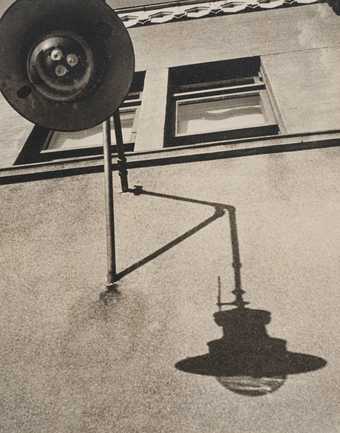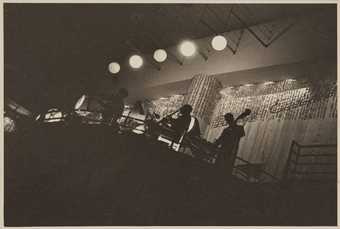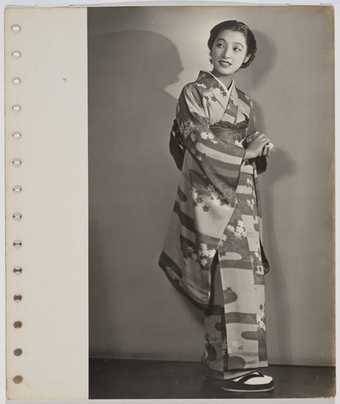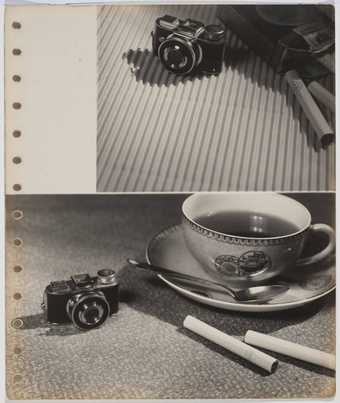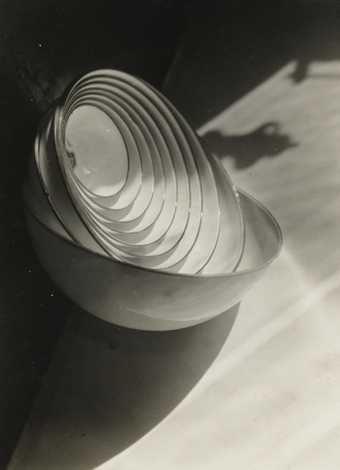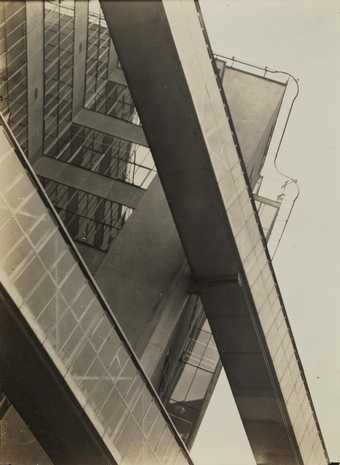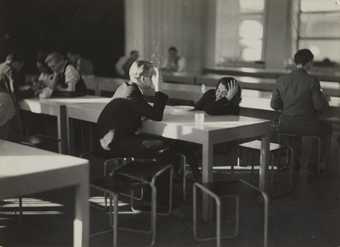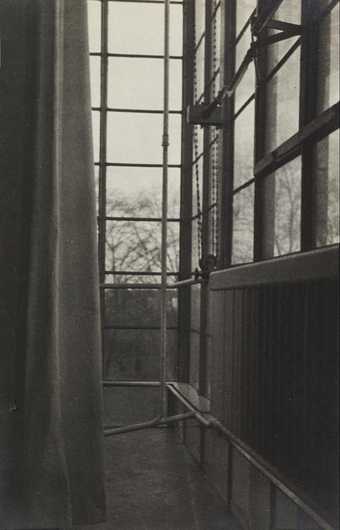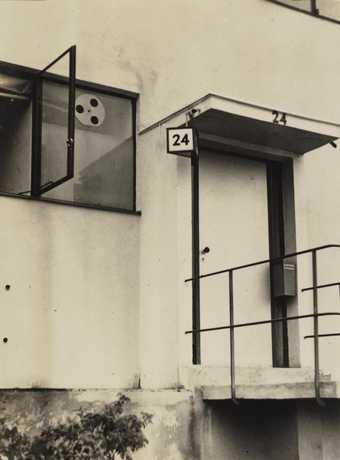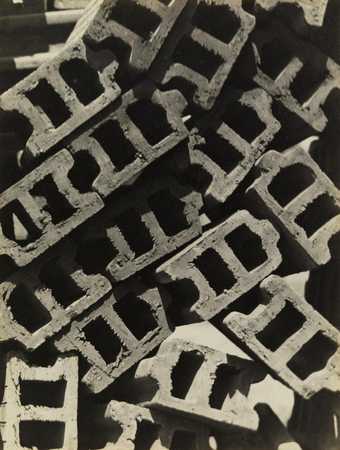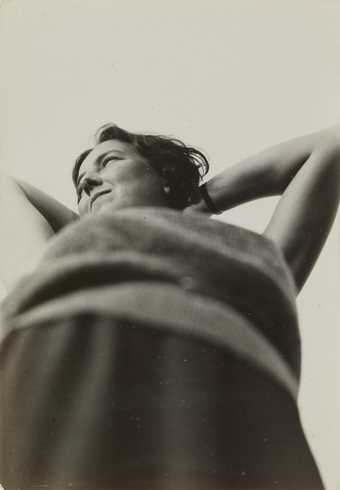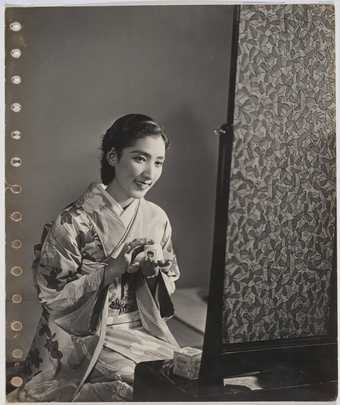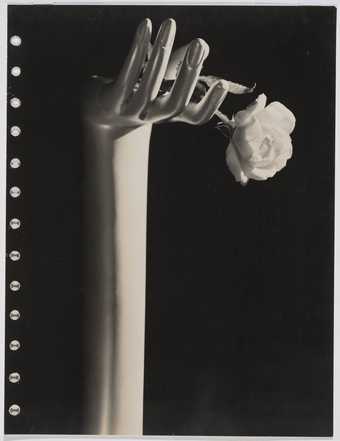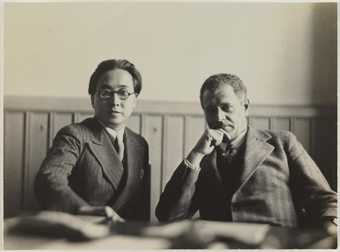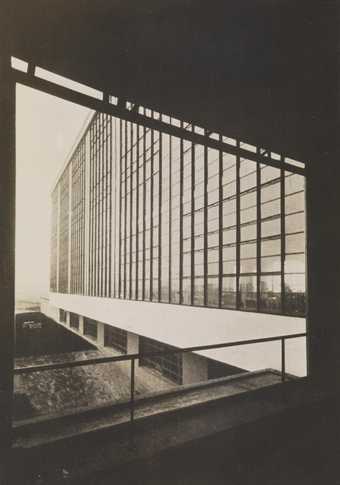
In Tate Liverpool
- Artist
- Iwao Yamawaki 1898–1987
- Medium
- Photograph, gelatin silver print on paper
- Dimensions
- Support & image: 227 × 167 mm
- Collection
- Tate
- Acquisition
- Purchased with funds provided by the Asia-Pacific Acquisitions Committee 2010
- Reference
- P79892
Summary
Untitled (Building in Moscow) is a small black and white photograph by the Japanese photographer Iwao Yamawaki. The photograph has been taken at an angle so that the building occupying most of the frame appears on the diagonal. The corner of the building is largely made of a glass column constructed from a large number of small windows in thin dark frames. The column is surrounded by angular box-like structures and topped by a flat roof. On the façade of the building Russian text runs down the wall to meet a canopy overhung with banners which supports a billboard displaying an image. Two vehicles are parked on the cobbled street and a group of three or four people gather outside while others pass by.
This photograph was taken by Yamawaki in 1931 in Moscow and produced as a gelatin silver print on paper. The title of this and related photographs is a straightforward description of its subject. This is consistent with the tenets of the New Vision (Neue Shen), which was promoted by László Moholy-Nagy (1895–1946), whom Yamawaki greatly admired. Moholy-Nagy was a teacher at the Bauhaus, a school of art, design and architecture established by architect Walter Gropius in Weimar in 1919 (subsequently moving to Dessau in 1925–6). Yamawaki and his wife Michiko enrolled as students at the Dessau Bauhaus in 1930. Initially attending the Preliminary Course with Josef Albers and Wassily Kandinsky, Yamawaki studied architecture before switching course to study photography with Walter Peterhans. His photographs of the period document the buildings, objects and activities of the Dessau Bauhaus and other modernist architecture. On 2 March 1931 he wrote to an undisclosed recipient:
Aside from my profession as architect, I have for a while been frequenting the Bauhaus printing workshop, something I had taken an interest in back in Japan. But, since it is not my speciality, the job is too big for me.
(Quoted in Yamawaki 1985, p.63.)
However, this did not prevent Yamawaki from producing architectural photographs and portraits, as well as photographs of furniture and objects. It is not known how many photographs Yamawaki took during this period but there are ten examples in Tate’s collection (Tate P13184; P79892–P79899; P79914).
Yamawaki studied architecture at the Tokyo School of Arts (1921–6) and worked as an architect while following the activities of the Bauhaus in Japanese architectural journals. Articles such as ‘State Bauhaus’ and ‘Bauhaus Postscripts’ by Nakata Teinosuke, who had visited the Weimar Bauhaus, began to appear in print in Japan in 1924 and Yamawaki was stimulated by their ideas (Yamawaki 1985, p.56). In 1931 and 1932, while studying at the school, Yamawaki travelled to Berlin, Amsterdam and Moscow to photograph examples of modernist design and architecture. The photographs he made on these visits were initially used to illustrate the articles he published in Japanese architecture journals.
The importance of the Bauhaus for Yamawaki can be sensed in the tone of his report, on 4 September 1932, of its imminent closure: ‘The Gropius Bauhaus is now like a forgotten piece of work; it has submitted to stretching its huge corpse in the suburbs of Dessau’ (Yamawaki 1985, p.67). In October 1932 his photomontage The Blow Against the Bauhaus was removed from exhibition for fear of Nazi reprisals.
Further reading
Iwao Yamawaki, ‘Reminiscences of Dessau’, Design Issues, vol.2, no.2, Autumn 1985, pp.56–68.
Iwao Yamawaki, Karl Lagerfeld and Ingrid Sischy, Iwao Yamawaki, Göttingen 1999.
Beth Williamson
April 2016
Supported by Christie’s.
Does this text contain inaccurate information or language that you feel we should improve or change? We would like to hear from you.
Display caption
Born in Fujita, Nagasaki, Iwao Yamawaki studied architecture at the Tokyo School of Arts and after graduating worked as an architect in a construction company. During this time, he took pictures with his 35mm camera to support and document his architectural studies. In 1931 he travelled to Germany to study at the Bauhaus in Dessau and became heavily influenced by László Moholy-Nagy’s idea that photography could open up new ways of seeing the world beyond those available to the human eye. Yamawaki travelled widely in Europe and the Soviet Union, documenting modernist architecture and design, as well as capturing student life at the Bauhaus.
Gallery label, November 2015
Does this text contain inaccurate information or language that you feel we should improve or change? We would like to hear from you.
Explore
- architecture(30,960)
- periods and styles(5,198)
-
- modernist(155)
- townscapes / man-made features(21,603)
-
- building - non-specific(3,161)
- formal qualities(12,454)
-
- photographic(4,673)
- group(4,227)
- cities, towns, villages (non-UK)(13,323)
-
- Moscow(15)
- Europe(267)
- Europe, Eastern Europe(229)
- Russia(46)
- transport: land(2,189)
-
- lorry(56)
You might like
-
Shikanosuke Yagaki Untitled (Street lamp and shadow)
1930–9 -
Shikanosuke Yagaki Jazz
1930–9 -
Ryukichi Shibuya Untitled (Advertising photograph, woman in kimono)
c.1936 -
Ryukichi Shibuya Untitled (Cigarettes, camera & coffee)
c.1936 -
Iwao Yamawaki Set of Bowls
1930–2 -
Iwao Yamawaki Untitled (Modernist architecture)
1930–2 -
Iwao Yamawaki Cafeteria after lunch, Bauhaus, Dessau
1930–2, printed later -
Iwao Yamawaki Untitled (Interior, Bauhaus, Dessau)
1930–2 -
Iwao Yamawaki In Dessau (Modernist architecture)
1930–2 -
Iwao Yamawaki Untitled (Composition with bricks, Bauhaus)
1930–2 -
Iwao Yamawaki Bauhaus Student
1930–2 -
Ryukichi Shibuya Untitled (Advertisement for Laito Cream)
c.1936 -
Ryukichi Shibuya Untitled (Advertising photograph, mannequin hand and flower)
c.1936 -
Iwao Yamawaki Untitled (Portrait of Yamawaki with Paul Oud)
1930–2

